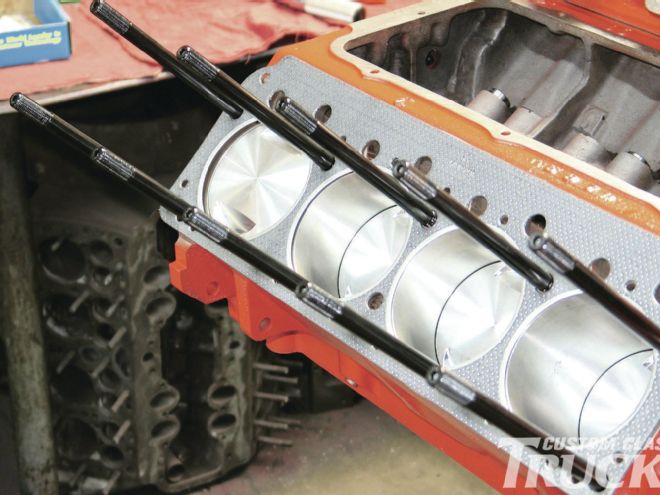
Since the first internal combustion engine sputtered to life there have been a host of technological advancements made, but regardless of how many carbs, computers, injectors, cams, or valves they are equipped with, the amount of power produced is a direct result of how well they process the air required for combustion.
One limitation of most engines is that they rely on atmospheric pressure to fill the cylinders. As the piston descends on the intake stroke a vacuum is created and atmospheric pressure causes air to flow through the intake tract, past the open valve and into the cylinder. But atmospheric pressure varies with the weather and most notably with altitude. As a result a normally aspirated engine, one that depends on atmospheric pressure alone, will run better at sea level where there is more atmospheric pressure than it will going over a 10,000-ft. mountain pass where the pressure is less. But add a pump, or a supercharger, that forces air into the engine and it's a different story.
How well the cylinders fill during the intake stroke is described as volumetric efficiency, or VE, and it's the difference between the theoretical maximum amount of air (or air and fuel) each cylinder can take in during the intake cycle compared to the actual amount taken in. For contemporary, naturally aspirated engines, a VE around 70 percent is close to the norm, over 90 percent is excellent, 100 percent is possible, and some competition engines can exceed 110 percent. Keep in mind these numbers are simply examples, but to put things in perspective, consider a modified 350ci engine running at 80-percent efficiency; the result is a powerplant that performs like it has 20-percent less displacement, or 280 cubic inches. Take that engine and add a supercharger and it's possible to get a denser air/fuel mixture into the cylinders. A little boost (the amount of air pressure created by the supercharger) can result in a dramatic increase of VE; at 130 percent, that same 350 is now being stuffed with the equivalent of 455 cubic inches of fuel and air. The bottom line is blown engines perform as if they had more displacement and as a result they produce more power.
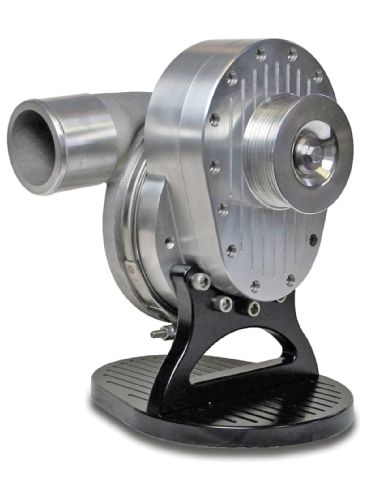 TorqStorm’s billet aluminum beauty is state of the art in centrifugal supercharger technology. The gear-driven impeller rides on ceramic bearings for long life.
TorqStorm’s billet aluminum beauty is state of the art in centrifugal supercharger technology. The gear-driven impeller rides on ceramic bearings for long life.
Like the engines they're attached to, superchargers come in a variety of configurations. They may be crankshaft driven like a centrifugal or Roots type, exhaust driven like a turbocharger, and at one time superchargers driven by an electric motor were available. But regardless of the drive, there are basically two types of superchargers—fixed displacement and non-fixed displacement. Roots types pump a given amount of air per revolution. It should be noted that Roots superchargers do not compress air, they move it from the blower's intake port to its exhaust port—the increase in pressure, or boost, takes place in the intake manifold. But while Roots blowers are simple and reliable, the disadvantage is they heat the incoming air more than the non-fixed displacement designs.
Centrifugal superchargers (crankshaft and exhaust driven) are not positive displacement because they do not move a fixed volume of air per revolution. The centrifugal supercharger impeller draws air into the center of the housing, it's then pushed to the outside of the impeller's blades by centrifugal force where it travels through a scroll that increases pressure. Centrifugal superchargers are simple and reliable and are ideal for "blowing through" fuel-injection throttle bodies.
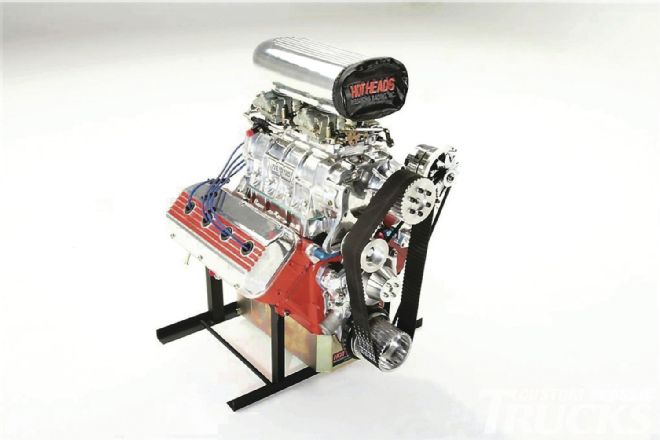 Familiar to most hot rodders is the GMC Roots-style blower. Hot Heads offers complete kits for Chrysler Hemis.
Familiar to most hot rodders is the GMC Roots-style blower. Hot Heads offers complete kits for Chrysler Hemis.
Similar to crankshaft-driven centrifugal superchargers are turbochargers; the most noticeable difference is a turbo is driven by the engine's exhaust. On one side of the turbocharger the exiting gasses pass through a housing spinning an impeller on a shaft. The other end of that shaft has an impeller in a separate housing—that is the compressor section feeding the engine. While turbochargers are effective, they can suffer what is commonly called "turbo lag" or a delay in throttle response because the compressor wheel has to get up to speed to create boost.
Some of the fears of supercharging are that the engine will be difficult to drive on the street, unreliable, and will guzzle gas. The truth is a properly prepared blown engine won't be any more hassle than any other performance engine. About the only real concern is changing oil regularly, particularly when the supercharger's bearings are lubricated by pressurized oil from the engine. As for reliability, most superchargers will outlast the engine it's mounted on. And while no one builds a blown engine with economy as the primary goal, a Roots blower will usually cause a small drop in mileage, centrifugals and turbos little or none—of course if you've got the throttle pedal mashed to the floor constantly you'll pay to play.
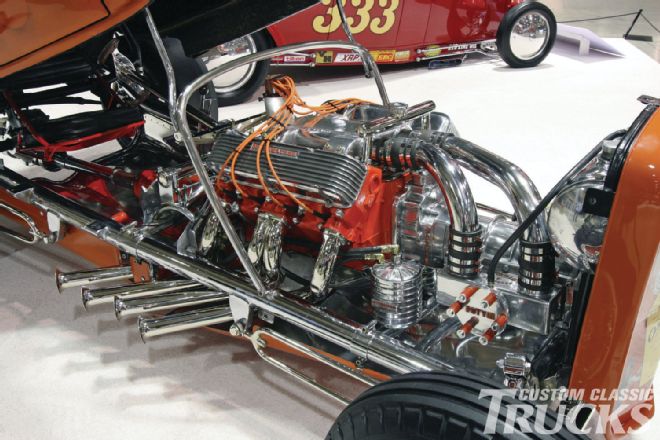 The famous 1932 Ford drag car, the Orange Crate, used a Potvin front-drive GMC blower on an Olds engine. A Roots blower will only provide boost when the air is available; that means boost is a function of throttle position.
The famous 1932 Ford drag car, the Orange Crate, used a Potvin front-drive GMC blower on an Olds engine. A Roots blower will only provide boost when the air is available; that means boost is a function of throttle position.
When deciding to supercharge an engine, one frequently asked question is "how much boost will the engine tolerate?" The answer is—it depends. The biggest factor determining how much boost can be run is the engine's compression ratio. Generally speaking, the static compression ratio of the engine being supercharged should be in the 8.0:1 to 9.0:1 range. In most cases, the higher the static compression, the lower the boost level will have to be. On the other hand, compression can't be too low as it will result in an engine that is "lazy" when no boost is present.
Other common concerns are the engine modifications necessaryto accommodate supercharging. Not to oversimplify, but the more boost, the more modifications are necessary. For low-boost applications, 3 to 4 pounds on a sound, stock engine will suffice; cast pistons will even live. Upping the boost to 5 to 9-pounds will call for the next level of modifications, and 10 or more will call for some serious preparation. But let's look at it from a component standpoint.
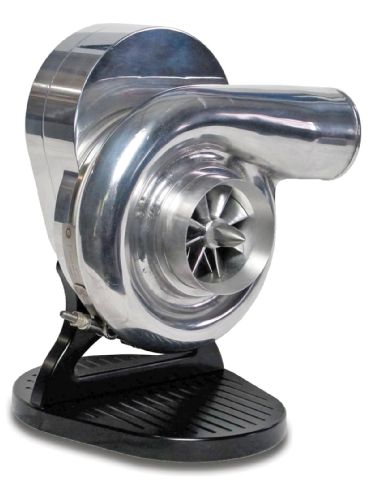 It’s easy to see why the TorqStorm is a centrifugal supercharger—air is taken in at the center of the impeller and is thrown out of the blades in the scroll that delivers it to the engine.
It’s easy to see why the TorqStorm is a centrifugal supercharger—air is taken in at the center of the impeller and is thrown out of the blades in the scroll that delivers it to the engine.
Block
Try to keep any overbore to a minimum to preserve cylinder-wall integrity, and investing in sonic checking isn't a bad idea if you have doubts about the thickness of the cylinder walls. Two-bolt mains are adequate on the street, although main studs are a wise addition. If four-bolt main blocks are available for your application, they're advisable, and for more than 10 pounds of boost, they should be added to any block if it's feasible.
Crankshafts
Cast crankshafts will suffice in low-boost, low-rpm situations, but forged cranks are generally preferred when boost goes much past 8 pounds or the engine will exceed 6,000 rpm.
Rods
Most factory steel rods are good to 8 to 10 pounds of boost, but as a precaution, they should be fitted with aftermarket bolts. However, keep in mind many aftermarket rods are now available for not much more that the cost of rebuilding a set of stockers. Full-floating piston pins are recommended.
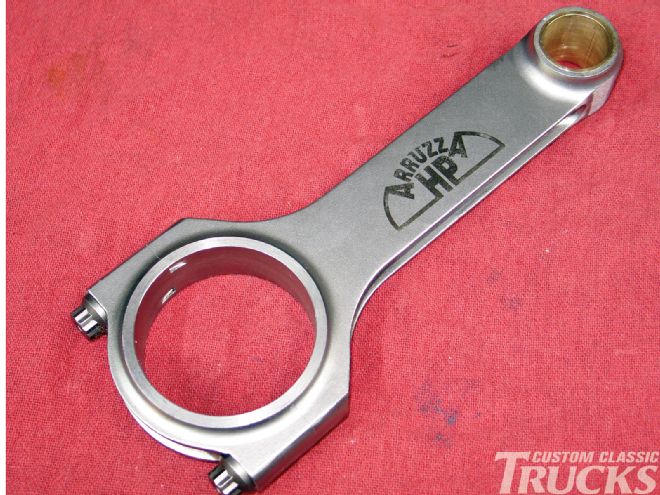 When building a blown engine with boost 6 pounds or higher, performance connecting rods are a wise investment. These rods for a Hemi are from Hot Heads.
When building a blown engine with boost 6 pounds or higher, performance connecting rods are a wise investment. These rods for a Hemi are from Hot Heads.
Pistons
While factory cast pistons will work at low-boost levels, forged pistons are a better choice due to their strength and the ability to handle elevated combustion temperatures (which happens with more mixture in the cylinders). An alternative with moderately boosted engines are hypereutectic pistons; they split the difference between cast and forged pistons in both price and strength categories. But the fact is if you're building a blown motor the pistons aren't the place to try and save money.
Heads
Because the blower is doing the work in terms of filling the cylinders, the heads don't normally require significant modifications for low boost levels. Moderate boost levels call for ports and bowls to be cleaned up and large ports and valves will be of benefit with big boost numbers.
Camshaft
The real difference in cams for blower motors has to do with lobe centers, or the separation between the intake and exhaust lobes. Wide-lobe centers, 112 to 114 degrees, spread the valve events apart, which means less overlap (during the period when the exhaust valve is not quite closed and the intake is just beginning to open, so both valves are in fact open) and results in more cylinder pressure. Of course, that's just another way of saying there's more stuff in the cylinder to burn, and that makes more heat. So what happens is this: Wider lobe centers equal more power and more heat; closer lobe centers equal less power, but a cooler-running engine with less chance of detonation.
Another area of cam design for blown engines that is often discussed is duration. Many engine builders favor a split-pattern cam, which is another way of saying a cam with more duration on one valve event than the other. For blown engines, there is often more duration on the exhaust because the blower is doing the work filling the cylinders on the intake stroke more effectively, so more duration on the exhaust just gives the piston more time to clear the spent gasses from the cylinder.
Finally, a blower has a tendency to calm a radical cam, so you can get away with more duration on the street than you could with a naturally aspirated engine. The bottom line is a blower makes up for a lot of an engine's shortcomings and even a relatively stock cam will work; more lift and longer duration just give the blower more opportunity to fill the cylinders.
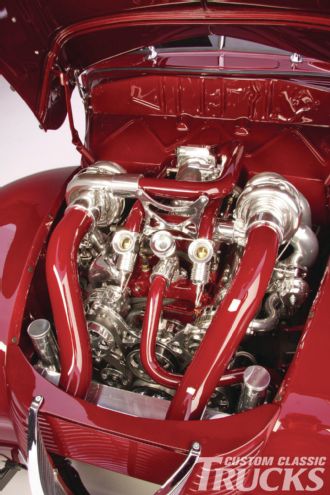 Dave Rios opted for twin Garrett turbochargers feeding electronic fuel injection on this 406-inch small-block Chevy. All the necessary plumbing, and there is a lot of it, was beautifully executed by the crew at Hot Rod Service Company. Photo by Eric Geisert.
Dave Rios opted for twin Garrett turbochargers feeding electronic fuel injection on this 406-inch small-block Chevy. All the necessary plumbing, and there is a lot of it, was beautifully executed by the crew at Hot Rod Service Company. Photo by Eric Geisert.
Vibration Dampers Versus Hubs
A vibration damper does just that: It cancels out the harmonics that occur in the crankshaft as the power produced in the cylinders is applied to it. In most cases, the vibration damper also mounts a pulley that drives the engine's accessories, such as the water pump, alternator, etc. The problem is that most stock vibration dampers aren't strong enough to withstand the stress of a Roots-style blower.
One way to deal with that issue is to replace the vibration damper with a solid steel hub. In most cases, the blower and belt tend to do the same thing as a vibration damper, just not as well. We prefer to use a vibration damper that is designed for the task of mounting pulleys and driving a blower.
Induction
No matter what kind of system is in use, carburetors or fuel injection, a blown engine has the capacity to use lots of fuel and the last thing you want to do is run it too lean. And while there are lots of variables due to engine displacement, type of induction, and so on, a high-capacity fuel pump (or in some cases, pumps) and large lines should always be part of the package.
Ignition
All performance engines need a strong spark; those with blowers are no different. However, blown engines often have unique needs in terms of the advance curve.
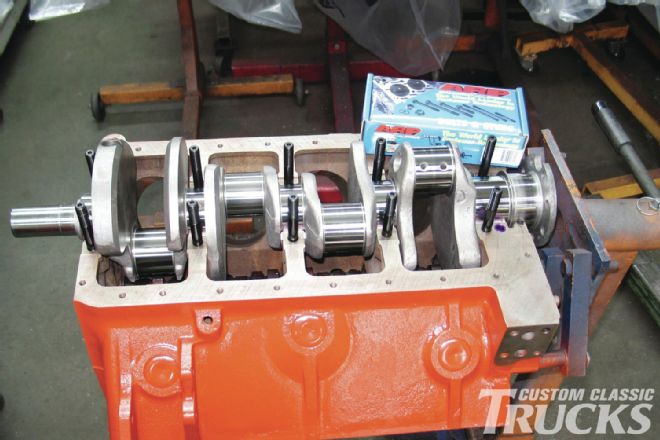 For low boost levels a stock bottom end will suffice, however, main studs are advisable.
For low boost levels a stock bottom end will suffice, however, main studs are advisable.
Exhaust
It stands to reason if a blower puts more air into the engine, there's more that has to get out. That means, in most cases, 2½ inches is the minimum exhaust system size, and 3 inches is better when the boost gets into double digits.
Cooling System
More power equals more heat. Cram in as much radiator as possible, run the biggest fan that will fit, use a shroud and a recovery tank.
Stick around and we'll show how to put your truck under pressure, make it haul, and keep it together.